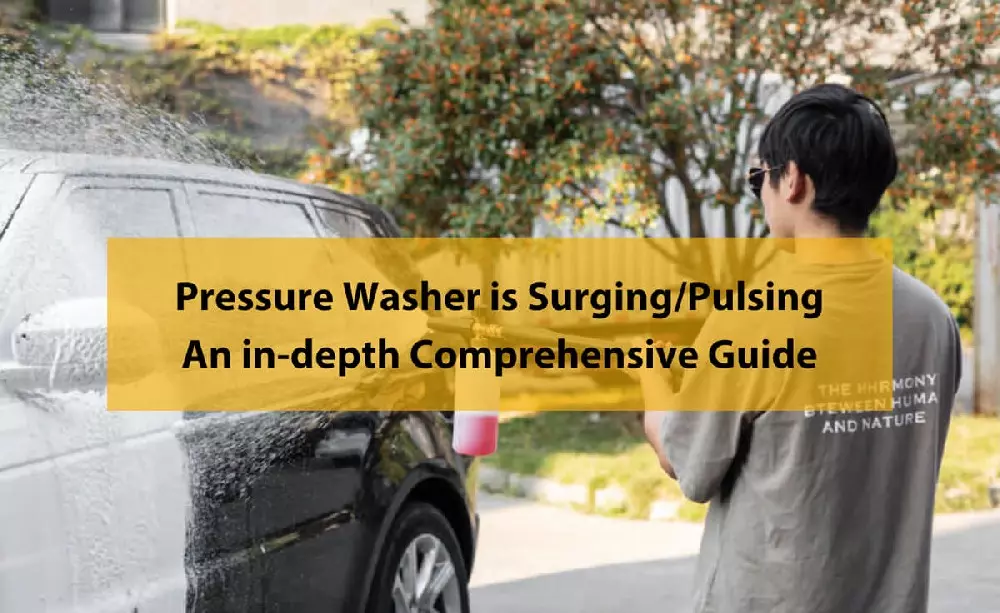고압 세척기가 급증/펄싱합니다. 심층적인 종합 가이드
2023-11-03
목차
고압 세척기는 가정 유지 관리 및 전문 세척 서비스의 필수품이 된 강력한 도구이지만, 때때로 급증이나 맥동과 같은 문제가 발생할 수 있습니다. 이러한 현상은 물의 꾸준한 흐름을 방해하여 비효율적인 세척과 잠재적으로 표면을 손상시킬 수 있습니다. 이 포괄적인 가이드는 문제 , 원인 , 진단 방법 , 궁극적으로 해결 방법을 포함하여 고압 세척기 급증/맥동을 이해하는 데 도움이 됩니다 .

고압 세척기 급증/펄싱이 무엇을 의미하는지 이해
고압 세척기의 맥락에서 급증 또는 펄싱은 물의 흐름이 일정하지 않은 것을 말합니다 . 꾸준하고 강력한 물의 흐름 대신, 압력이 변동하여 물이 폭발적으로 또는 펄스적으로 나옵니다. 이러한 불규칙성은 세척 효율성에 영향을 미칠 뿐만 아니라, 그대로 두면 기계 구성품의 마모로 이어질 수도 있습니다. 게다가, 압력이 일정하지 않으면 세척 작업에 더 많은 시간이 소요될 수 있으며, 작업의 질이 떨어질 수도 있습니다.
고압 세척기 급증/펄싱의 일반적인 원인
고압 세척기 서지 또는 펄스는 다양한 문제로 인해 발생할 수 있습니다. 다음은 일반적인 원인 목록입니다.
꼬임과 막힘 : 이로 인해 물의 흐름이 제한되어 압력이 일정하지 않게 발생할 수 있습니다.
노즐이 막힘 : 시간이 지나면서 노즐 내부에 이물질이 쌓여서 노즐이 막히고 수압이 저하될 수 있습니다.
더러운 유입 또는 배출 밸브 : 이러한 밸브가 더러우면 제대로 열리고 닫히지 않아 수압이 불규칙해질 수 있습니다.
결함 있는 압력 조절기 : 조절기는 수압을 조절합니다. 손상되거나 오작동하는 경우 압력이 변동될 수 있습니다.
마모된 펌프 씰 : 이 씰은 펌프에서 물이 새는 것을 방지합니다. 마모되거나 손상되면 공기가 펌프로 들어가 맥동을 일으킬 수 있습니다.
펌프에 공기가 들어감 : 펌프가 공기와 물을 모두 밀어내는 데 어려움을 겪으면서 압력이 일정하지 않게 될 수 있습니다.
고압 세척기의 급증/펄싱에 대한 솔루션 및 수정
일반적으로, 급증하는 고압 세척기의 문제 해결을 위한 첫 번째 단계는 스프레이 노즐에 먼지가 있는지 확인하는 것입니다. 언로더 밸브에 손상이나 공기가 갇혔는지 확인하여 노즐이 괜찮은지 확인합니다. 호스와 필터에 누출이나 제한이 있는지 확인합니다. 없으면 고압 세척기의 물 공급과 밸브를 확인합니다.
이 과정에서는 안전이 가장 중요합니다. 검사를 시작하기 전에 항상 고압 세척기가 꺼져 있고 전원에서 분리되어 있는지 확인하십시오.
노즐을 확인하세요
대부분의 경우, 고압 세척기의 노즐이 압력 증가의 주요 문제입니다. 고압 세척기의 노즐을 확인하세요. 다른 노즐을 장착하여 문제가 해결되는지 확인하세요. 그렇다면 노즐이 더러울 가능성이 큽니다.
먼지가 내부에 있으면 얇은 금속 와이어로 청소하거나 노즐 세척 키트를 사용하십시오. 노즐이 마모된 경우 노즐을 교체해야 합니다.
언로더 밸브를 확인하세요
두 번째 단계는 언로더 밸브를 확인하는 것입니다. 이것은 펌프에서 바이패스로 물 흐름을 전환합니다. 이 언로더는 또한 고압 세척기 노즐에서 물이 쌓이는 압력을 완화할 수 있습니다.
언로더는 물 입구 위에 있습니다. 언로더를 찾아서 열어서 막혔거나 마모되었는지 확인하십시오. 언로더 밸브를 약간 조정하여 와셔 압력을 높일 수 있습니다. 언로더 밸브를 조정할 때 압력 게이지를 연결하여 압력이 너무 높아지는 것을 방지하십시오.
언로더 밸브 조정 시 압력을 확인하고 최상의 설정을 찾으세요. 트리거를 놓을 때 보이는 스파이크는 10%를 초과해서는 안 됩니다. 높은 스파이크는 고압 세척기의 내부 부품을 손상시킬 수 있습니다.
언로더 밸브를 조정한 후에도 기계에서 여전히 낮은 압력이 생성되면 밸브가 손상되었을 수 있으며 교체해야 합니다.
호스와 필터를 확인하세요
입구 호스와 필터를 점검하여 저압을 유발하는 제한이 있는지 확인하세요. 이 경우 호스를 철저히 청소하세요. 사용하는 수도꼭지가 완전히 열려 있는지 확인하세요.
고압 세척기나 호스에 공기가 갇혔을 수도 있습니다. 고압 세척기에서 호스를 분리합니다. 물만 나올 때까지 물을 흐르게 합니다. 호스를 고압 세척기에 다시 연결합니다. 이제 방아쇠를 당겨 잠시 물을 흐르게 합니다. 이렇게 하면 시스템에서 공기가 제거됩니다.
급수 테스트
때때로, 공급원이 고압 세척기에 충분한 물을 공급하지 못할 수 있습니다. 이로 인해 노즐에 캐비테이션이나 기포가 형성될 수 있습니다. 캐비테이션은 고압 세척기에 충분한 물이 도달하지 않는다는 명확한 신호입니다.
대부분 제조업체는 분당 2갤런(GPM)이 필요하다고 말합니다. 하지만 저희의 경험에 따르면 돈이 덜 들더라도 여전히 잘 작동합니다. 하지만 최소 0.9GPM의 흐름이 있는지 확인하세요. 적합한 호스를 사용하는 것이 좋습니다. 압력 세척기에 쌓이는 것을 방지하기 위해 최소 직경은 ¾인치여야 합니다. 호스가 길수록 적절한 호스가 더욱 중요합니다.
물 공급이 양호하다고 가정합니다. 펌프 패킹을 점검합니다. 마모되었다면 교체합니다.
고압 세척기 밸브를 확인하세요
펄싱 고압 세척기 문제 해결의 마지막 단계는 밸브를 확인하는 것입니다. 입구 또는 배출 밸브가 제대로 작동하지 않으면 교체해야 합니다. 입구 밸브는 물을 매니폴드로 보냅니다. 플런저는 입구 밸브가 닫히면서 물을 배출 밸브 쪽으로 밀어냅니다.
배출 밸브는 물을 방출합니다. 펌프 외부에 있습니다. 밸브가 제대로 작동하는 경우 밸브 스프링을 확인하세요. 부러질 수 있습니다. 이 경우 교체하세요.
펌프에 공기가 있는지 확인하세요
펌프에 공기가 있다는 징후에는 기계에서 이상한 소음이나 진동이 포함될 수 있습니다. 갇힌 공기를 제거하려면 세척 막대를 부착하지 않은 채 고압 세척기를 켜고 약 5~10분 동안 물을 흐르게 합니다. 이 절차는 갇힌 공기를 밀어내야 합니다.
고압 세척기 급증/펄싱을 방지하기 위한 예방 조치
고압 세척기의 급증이나 펄싱을 방지하려면 정기적인 유지관리가 필요합니다. 이전에 고압 세척기를 수리한 적이 없더라도 다음 문단에서는 정기적인 고압 세척기 유지관리에 대해 알아야 할 모든 것을 알려드립니다.
사용하기 전에
가솔린 차량의 경우 오일과 연료 수준을 확인하세요.
고압 세척기의 막대 확장 부분이 막히지 않았는지 확인하세요.
스프레이 건의 방아쇠와 잠금장치를 확인하세요. 스프레이 건이 제대로 작동하지 않으면 교체하세요.
고압 라인과 호스 연결부에 절단, 팽창, 누출 또는 기타 손상이 있는지 확인하십시오. 호스가 손상된 경우 제조업체의 교체 지침을 읽으십시오.
일정한 GPM으로 물 공급이 이루어지는지 확인하려면 물 공급원을 확인하세요.
언로더 밸브에 마모나 손상이 없는지 정기적으로 검사하고 올바르게 조정되었는지 확인하세요.
고압 세척기를 시작하기 전에 펌프에 공기가 없는지 확인하세요. 세척 막대를 부착하지 않고 물을 기계에 흘려보내면 됩니다.
사용 후
트리거를 잠그고 고압 세척기를 식힙니다. 고압 스프레이 건, 정원 호스, 막대 연장부를 분리합니다.
펌프에서 남은 물을 모두 빼냅니다. 가스 구동 모델을 사용하는 경우 리코일 핸들을 약 6번 당깁니다. 전기식 모델을 사용하는 경우 펌프가 물을 펌핑하기 시작할 때까지 켠 다음 재빨리 끕니다.
결론
서징 또는 펄싱 고압 세척기의 원인과 해결책을 이해하는 것은 장비의 효율성과 수명을 유지하는 데 중요합니다. 정기적인 점검 및 유지 관리를 통해 이러한 문제를 예방하여 고압 세척기가 계속해서 최적의 성능을 발휘하도록 할 수 있습니다. 이 가이드를 통해 서징 또는 펄싱 문제를 진단하고 해결하기 위한 올바른 단계를 밟아 고압 세척기가 앞으로도 수년간 효과적으로 작동하도록 할 수 있습니다.
고압 세척기 문제 해결에 대해 자세히 알아보세요.

